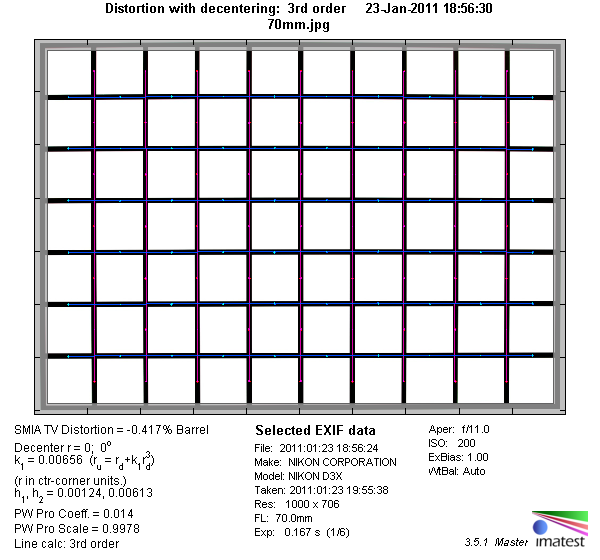|
Sigma AF 70-300mm f/4-5.6 DG OS (FX) - Review / Test Report - Analysis |
|
Lens Reviews -
Nikon / Nikkor (full format)
|
|
Page 2 of 3

Distortion
The Sigma lens shows a slight amount of barrel distortion at 70mm and moderate pincushion distortion from 135mm and towards the long end. This is typical for a lens in this class.
|
Move the mouse cursor over the focal length text marks below to observe the respective distortion
|
| 70 mm |
135 mm |
200 mm |
300 mm |
|

|
The chart above has a real-world size of about 120x80cm.
Vignetting
Vignetting is visibe at max. apertures but comparatively well controlled at around 1 EV. Closing the aperture by one f-stop solves most of the issue from a real-life perspective.
We're performing our vignetting analysis based on
(uncorrected) JPEGs straight from the camera. The JPG engine of the Nikon D3x features a rather flat
gradation curve, thus has a moderate contrast characteristic, resulting in comparatively low vignetting figures - the
corresponding Canon figures are roughly 40% higher due to the more
aggressive default contrast setting.

MTF (resolution)
At its short end the lens delivers very good sharpness in the image center with good corners and good to (just) very good border resolution. At 135mm the image center is a bit sharper, but borders and corners start lower and the lens needs to be stopped down to f/8 to reach very good resolution here.
At 200 mm the image center is still very good, however the borders and corners drop considerably in resolution. The situation is even worse at 300mm, where the image center resolution has dropped to good values and the borders and corners are outright poor.
Please note that the MTF results are not directly comparable across the different systems!
Below is a simplified summary of the formal findings. The chart shows line widths
per picture height (LW/PH) which can be taken as a measure for sharpness.
If you want to know more about the MTF50 figures you may check out the corresponding
Imatest Explanations

Chromatic Aberrations (CAs)
Good news first: chromatic aberrations (color shadows at harsh contrast transitions) are well controlled at the medium focal lengths. At both ends of the focal range though they are rather high, reaching up to 2 pixels at 300mm and excessing 4 pixels (and thus our scale in the chart) at 70mm.
However, please note that lateral CAs can easily be corrected in software or by the camera itself (most modern Nikon DSLRs remove CAs on-the-fly if you shoot JPGs).

|